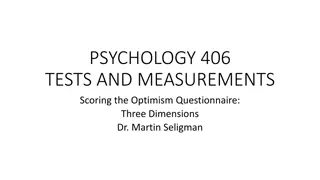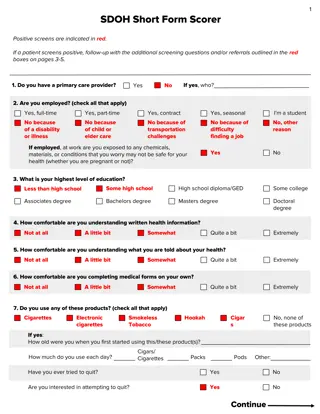
Importance of Questionnaires in Research
Discover the significance of questionnaires in research, ranging from their origins in the 19th century to their modern-day applications. Learn about the advantages of well-designed questionnaires, characteristics of effective surveys, and the critical role they play in collecting valuable data for analysis and decision-making.
Download Presentation

Please find below an Image/Link to download the presentation.
The content on the website is provided AS IS for your information and personal use only. It may not be sold, licensed, or shared on other websites without obtaining consent from the author. If you encounter any issues during the download, it is possible that the publisher has removed the file from their server.
You are allowed to download the files provided on this website for personal or commercial use, subject to the condition that they are used lawfully. All files are the property of their respective owners.
The content on the website is provided AS IS for your information and personal use only. It may not be sold, licensed, or shared on other websites without obtaining consent from the author.
E N D
Presentation Transcript
WHAT IS A QUESTIONNAIRE?
A questionnaire is a research instrument that consists of a set of questions or other types of prompts that aims to collect information from a respondent. A research questionnaire is typically a mix of close-ended questions and open-ended questions. Open-ended, long-form questions offer the respondent the ability to elaborate on questionnaires were developed in 1838 by the Statistical Society of London. The data collected from a data collection questionnaire can be both qualitative as well as quantitative in nature. A questionnaire may or may not be delivered in the form of a survey, but a survey always consists of a questionnaire. their thoughts. Research
Advantages of a good questionnaire design With a survey questionnaire, you can gather a lot of data in less time. There is less chance of any bias(like selection bias) creeping if you have a standard set of questions to be used for your target audience. You can apply logic to questions based on the respondents answers, but the questionnaire will remain standard for a group of respondents that fall in the same segment. Surveying online survey software is quick and cost-effective. It offers you a rich set of features to design, distribute, and analyze the response data. It can be customized to reflect your brand voice. Thus, it can be used to reinforce your brand image. The responses can be compared with the historical data and understand the shift in respondents choices and experiences. Respondents can answer the questionnaire without revealing their identity. Also, many survey software complies with significant data security and privacy regulations.
Characteristics of a good questionnaire Your survey design depends on the type of information you need to collect from respondents. Qualitative questionnaires are used when there is a need to collect exploratory information to help prove or disprove a hypothesis. Quantitative questionnaires are used to validate or test a previously generated hypothesis. However, most questionnaires follow some essential characteristics:
Uniformity: collect demographic information, personal opinions, facts, or attitudes from respondents. One of the most significant attributes of a research form is uniform design and standardization. Every respondent sees the same questions. This collection and statistical analysis of this data. For example, the retail store evaluation questionnaire template contains questions for evaluating retail store experiences. Questions relate to purchase value, range of options for product selections, and quality of merchandise. These questions are uniform for all customers. Questionnaires are very useful to helps in data
Exploratory: It should be exploratory to collect qualitative data. There is no restriction on questions that can be in your questionnaire. For example, you use a data collection questionnaire and send it to the female of the household to understand her spending and saving household income. Open-ended questions give you more insight and allow the respondents to explain their practices. A very structured question list could limit the data collection. habits relative to the
Question Sequence: It typically follows a structured flow of questions to increase the number of responses. This sequence of questions is screening questions, warm-up questions, transition questions, skip questions, challenging classification questions. For example, our motivation and buying experience template covers initial demographic questions and then asks for time spent in sections of the store and the rationale behind purchases. questions, and questionnaire
Types & Definitions As we explored before, questionnaires can be either structured or free-flowing. Let s take a closer look at what that entails for your surveys. Structured Questionnaires: collect quantitative data. The questionnaire is planned and designed to gather precise information. It also initiates a formal inquiry, supplements accumulated data, and helps validate any prior hypothesis. Unstructured Questionnaires: Unstructured questionnaires collect qualitative data. They use a basic structure and some branching questions but nothing that limits the responses of a respondent. The questions are more open-ended to collect specific data from participants. Structured questionnaires data, checks previously
Types of questions in a questionnaire You can use multiple question types in a questionnaire. Using various question types can help increase responses to your research questionnaire as they tend to keep participants more engaged. The best customer satisfaction survey templates are the most commonly used for better insights and decision-making. Some of the widely used types of questions are: Open-Ended Questions: Open-ended qualitative data in a questionnaire where the respondent can answer in a free form with little to no restrictions. Dichotomous Questions: The dichotomous question is generally a yes/no close-ended question. This question is usually used in case of the need for necessary validation. It is the most natural form of a questionnaire. questions help collect
Multiple-Choice Questions: Multiple-choice questions are a close-ended question type in which a respondent has to select one (single-select multiple-choice question) or many (multi-select multiple choice question) responses from a given list of options. The multiple-choice question consists of an incomplete stem (question), right answer or answers, incorrect answers, close alternatives, and distractors. Of course, not all multiple-choice questions have all of the answer types. For example, you probably won t have the wrong or right answers if you re looking for customer opinion. Scaling Questions: These questions are based on the principles of the four measurement scales nominal, ordinal, interval, and ratio. A few of the question types that utilize these scales fundamental questions, Likert scale questions, semantic differential scale questions, and Stapel scale questions. Pictorial Questions: This question type is easy to use and encourages respondents to answer. It works similarly to a multiple-choice question. Respondents are asked a question, and the answer choices are images. This helps respondents choose an answer quickly without over-thinking their answers, giving you more accurate data. properties are rank order






















